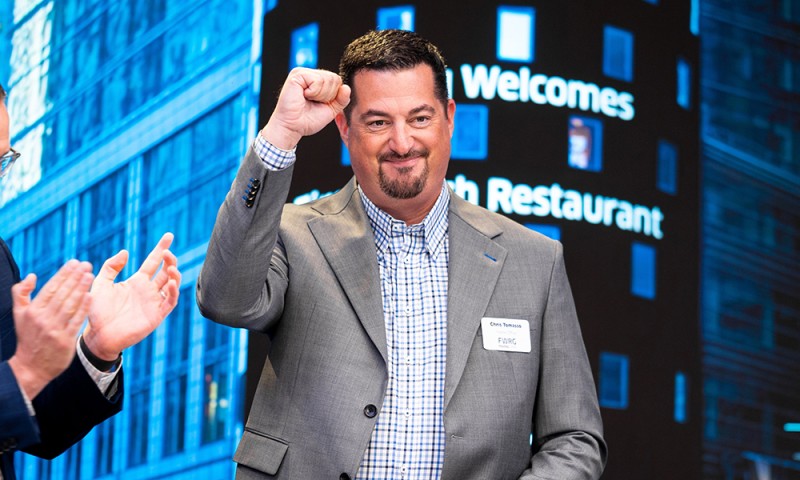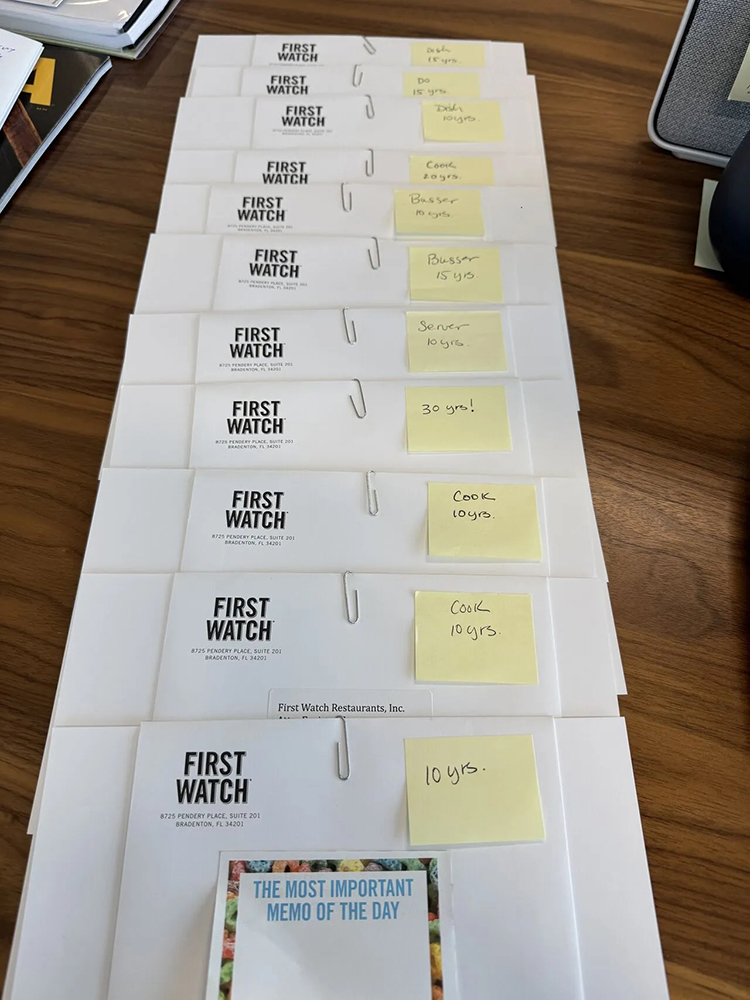
在人工智能化身与数字信息过载的时代,手写便条这类简单的举动仿佛成了历史遗物。事实上,许多Z世代甚至看不懂草书。
但对First Watch首席执行官克里斯·托马索(Chris Tomasso)而言,手写传统的致谢便条是一项惯例。
这位年营收10亿美元的早午餐连锁店掌舵人,每月都会抽空亲笔书写贺信,向庆祝重要里程碑——例如在公司工作满10年、20年乃至30年——的厨师和洗碗工致意。First Watch拥有超过1.5万名员工,而托马索已写下500多封便条。他相信,这一微小举动能产生超乎想象的影响。
“我欣赏那些选定职业赛道、热爱本职工作、心无旁骛的人,”托马索在接受《财富》杂志采访时表示,“他们力求成为最出色的洗碗工。因此,我要感谢并回报他们的忠诚、坚守以及为公司作出的贡献。”

托马索的这一做法可追溯至其职业生涯早期。26岁时,他收到了Hard Rock Café首席执行官的一封手写感谢信——这封信他珍藏至今。2018年,当托马索自己成为首席执行官时,他决定将这种“以人为本”的理念延续下去。
“与人交流时,我尽力淡化‘首席执行官’这个头衔,”托马索表示,“我和大家一样在休息室吃午餐——不知何故,新员工对此总是惊讶不已:我竟然就坐在他们身边,带着自己的午餐和他们一起吃饭。员工会有这种反应,反而让我觉得有些遗憾。”
这一简单举动折射出更深层的领导力启示:情感联结至关重要。
“我们的职责是创造一个让员工感到快乐、受重视的环境,其余的事情他们自会妥善处理,”托马索在领英(LinkedIn)上补充道,“而且他们会做得比任何人都好。”
致谢的力量
尽管科技让世界运转得更快,人际互动似乎也更缺乏人情味,但无数商界领袖认为,沉下心来寄送一封手写感谢信,其价值依然无可替代。
尼曼·马库斯(Neiman Marcus)首席执行官杰弗里·范·拉姆登克(Geoffroy van Raemdonck)长久以来一直保持这一习惯。疫情前,他每天都会寄出三到五封手写感谢信。随着远程和混合办公模式的普及,他现在会辅以短信、邮件和简短电话传递心意——但其中的真挚情谊始终未变。
“我的优秀导师们让我深刻认识到寄送感谢信的力量,”范·拉姆登克在2023年接受《财富》杂志采访时表示,“‘感谢’的时刻对我而言至关重要,因为我深知收到感谢、得到认可意味着什么。”
雪佛龙(Chevron)董事长兼首席执行官迈克·沃思(Mike Wirth)也会抽出时间,向这家全球能源巨头的全体员工寄送“传统纸质版”的感谢信。
“回想我职业生涯早期,如果一位首席执行官给我写信,并且真正了解我的工作内容,那对我而言意义重大,”沃思在戴维·诺瓦克(David Novak)主持的《领导者如何领导》(How Leaders Lead)播客节目中表示。“因此,我努力回想自己当年从事这些岗位时的心境,毕竟我也曾身处一线。我希望确保员工们知道,我由衷感激他们的付出。”
年轻一代的领导者也未曾遗失笔墨书写的艺术。例如,OpenAI首席执行官萨姆·奥尔特曼(Sam Altman)在解决问题时,就常常远离电子屏幕。
“我认为写作是思考的外化过程,”这位40岁的首席执行官在《我如何写作》(How I Write)播客节目中坦言。“当我遇到非常棘手的难题,或对某事感到困惑时,我至今仍未找到比坐下来、强迫自己动笔书写更好的方法。”
“我深信不疑的做法是:先记下大量笔记,然后干脆利落地把它们撕下来,以便我能同时浏览多页内容。写完读完后,我还可以把纸揉成一团扔在地上。”
最终,在人工智能持续重塑全球沟通方式的时代,提笔书写或许将不断证明:情感的联结,其力量远比一时的便利更为持久。(*)
译者:中慧言-王芳
在人工智能化身与数字信息过载的时代,手写便条这类简单的举动仿佛成了历史遗物。事实上,许多Z世代甚至看不懂草书。
但对First Watch首席执行官克里斯·托马索(Chris Tomasso)而言,手写传统的致谢便条是一项惯例。
这位年营收10亿美元的早午餐连锁店掌舵人,每月都会抽空亲笔书写贺信,向庆祝重要里程碑——例如在公司工作满10年、20年乃至30年——的厨师和洗碗工致意。First Watch拥有超过1.5万名员工,而托马索已写下500多封便条。他相信,这一微小举动能产生超乎想象的影响。
“我欣赏那些选定职业赛道、热爱本职工作、心无旁骛的人,”托马索在接受《财富》杂志采访时表示,“他们力求成为最出色的洗碗工。因此,我要感谢并回报他们的忠诚、坚守以及为公司作出的贡献。”
托马索的这一做法可追溯至其职业生涯早期。26岁时,他收到了Hard Rock Café首席执行官的一封手写感谢信——这封信他珍藏至今。2018年,当托马索自己成为首席执行官时,他决定将这种“以人为本”的理念延续下去。
“与人交流时,我尽力淡化‘首席执行官’这个头衔,”托马索表示,“我和大家一样在休息室吃午餐——不知何故,新员工对此总是惊讶不已:我竟然就坐在他们身边,带着自己的午餐和他们一起吃饭。员工会有这种反应,反而让我觉得有些遗憾。”
这一简单举动折射出更深层的领导力启示:情感联结至关重要。
“我们的职责是创造一个让员工感到快乐、受重视的环境,其余的事情他们自会妥善处理,”托马索在领英(LinkedIn)上补充道,“而且他们会做得比任何人都好。”
致谢的力量
尽管科技让世界运转得更快,人际互动似乎也更缺乏人情味,但无数商界领袖认为,沉下心来寄送一封手写感谢信,其价值依然无可替代。
尼曼·马库斯(Neiman Marcus)首席执行官杰弗里·范·拉姆登克(Geoffroy van Raemdonck)长久以来一直保持这一习惯。疫情前,他每天都会寄出三到五封手写感谢信。随着远程和混合办公模式的普及,他现在会辅以短信、邮件和简短电话传递心意——但其中的真挚情谊始终未变。
“我的优秀导师们让我深刻认识到寄送感谢信的力量,”范·拉姆登克在2023年接受《财富》杂志采访时表示,“‘感谢’的时刻对我而言至关重要,因为我深知收到感谢、得到认可意味着什么。”
雪佛龙(Chevron)董事长兼首席执行官迈克·沃思(Mike Wirth)也会抽出时间,向这家全球能源巨头的全体员工寄送“传统纸质版”的感谢信。
“回想我职业生涯早期,如果一位首席执行官给我写信,并且真正了解我的工作内容,那对我而言意义重大,”沃思在戴维·诺瓦克(David Novak)主持的《领导者如何领导》(How Leaders Lead)播客节目中表示。“因此,我努力回想自己当年从事这些岗位时的心境,毕竟我也曾身处一线。我希望确保员工们知道,我由衷感激他们的付出。”
年轻一代的领导者也未曾遗失笔墨书写的艺术。例如,OpenAI首席执行官萨姆·奥尔特曼(Sam Altman)在解决问题时,就常常远离电子屏幕。
“我认为写作是思考的外化过程,”这位40岁的首席执行官在《我如何写作》(How I Write)播客节目中坦言。“当我遇到非常棘手的难题,或对某事感到困惑时,我至今仍未找到比坐下来、强迫自己动笔书写更好的方法。”
“我深信不疑的做法是:先记下大量笔记,然后干脆利落地把它们撕下来,以便我能同时浏览多页内容。写完读完后,我还可以把纸揉成一团扔在地上。”
最终,在人工智能持续重塑全球沟通方式的时代,提笔书写或许将不断证明:情感的联结,其力量远比一时的便利更为持久。(*)
译者:中慧言-王芳
In an era of AI avatars and digital overload, something as simple as a handwritten note can feel like a relic of the past. In fact, many Gen Zers can’t even read cursive.
But for First Watch CEO Chris Tomasso, old-fashioned notes of appreciation are a ritual.
The leader of the $1 billion-a-year breakfast and lunch chain takes time each month to handwrite congratulations to cooks and dishwashers celebrating major milestones, like 10, 20, or even 30 years with the company. With more than 15,000 employees, Tomasso has penned over 500 notes—and believes the small gesture has an outsized impact.
“I just love people that pick their lane, they love it, and they don’t want to do anything else,” Tomasso told Fortune. “They want to be the best dishwasher they can, and so I want to thank and reward loyalty, longevity, [and] the contributions that they make to the company.”
Tomasso traces his approach to a moment early in his career. At 26, he received a handwritten thank-you note from his CEO at Hard Rock Café—a letter he’s kept to this day. When Tomasso became a CEO himself in 2018, he decided to carry that same people-first philosophy forward.
“I tried to minimize the [CEO] title as best I can when I’m interacting with people,” Tomasso said. “I eat lunch in the break room with everybody, which always, for whatever reason, blows new employees away—that I just sit down next to them and bring my lunch and have lunch with them. I think it’s a shame that there’s that feeling.”
It’s a simple act that reflects a broader leadership lesson: connection matters.
“Our job is to create an environment where our employees are happy and feel appreciated and they take care of the rest,” Tomasso added on LinkedIn. “And they do it better than anyone.”
The power of a thank-you
While technology has made the world faster and seemingly less personal, slowing down to send a handwritten thank-you note is a practice countless business leaders say still can’t be beat.
Geoffroy van Raemdonck, the CEO of Neiman Marcus, has long embraced the gesture. Before the pandemic, he would send three to five handwritten thank-you notes every day. With the shift to remote and hybrid work, he now supplements them with text, emails and quick phone calls—but the sentiment remains the same.
“I was taught by great mentors of the power of sending a thank-you note,” van Raemdonck told Fortune in 2023. “It’s really important for me—the moment of ‘thank you’—because I know what it is to receive a thank-you, to be acknowledged.”
Mike Wirth, chairman and CEO of Chevron, also takes time to send “old-school, on paper” messages of appreciation to employees across the global energy giant.
“I think back to when I was early in my career, and if a CEO had sent me a letter and actually knew what I was doing, it would have been a really big deal for me,” Wirth said on the How Leaders Lead podcast with host David Novak. “And so I try to remember what it was like to be in the jobs that I’m visiting and that I had those jobs myself one time. And I want to make sure that people know that I appreciate them.”
The art of putting pen to paper isn’t lost on younger leaders either. OpenAI CEO Sam Altman, for example, often ditches screens when he’s problem-solving.
“I think of writing as externalized thinking. I still, if I have a very hard problem, or if I feel a little bit confused about something, have not found anything better to do than to sit down and make myself write it out,” the 40-year-old said on the How I Write podcast.
“I’m a big believer of, I take a bunch of notes, and then I clearly rip them out so I can look at multiple pages at the same time, and I can crumple them up and throw them on the floor when I’m done.”
Ultimately, as AI continues to reshape how the world communicates, putting pen to paper may continue to prove that connection can outlast convenience.

